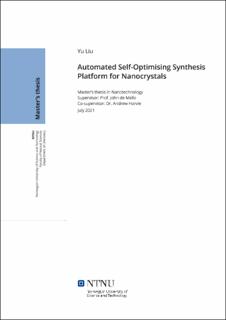| dc.description.abstract | Nanocrystals are semiconductor nanoparticles with proven potential to enhance many applications including bioimaging and optoelectronics. Traditional colloidal synthesis methods typically do not provide the necessary control and uniformity of the reaction conditions needed for reliable reproducibility, resulting in large variations in the size, shape and properties of the nanocrystals. Flow chemistry is an emerging branch of synthetic chemistry that has proven to provide superior control and uniformity in the reaction environment with continuous reagent delivery and production formation. In this report I describe a self-constructed flow platform for high temperature synthesis of copper indium sulphide based photoluminescent nanocrystals. The flow synthesis platform consists self-built components that are interfaced to a PC to achieve synthesis automation with real-time optical detection of the formed products. The inclusion of an on-line analysis system allows for rapid product assessment such one can sample and test multiple reaction conditions within a single reaction run. It also enables self-optimising synthesis in which the reactor automatically finds reactoin conditions that give particles with desired properties by coupling the platform with an optimisation algorithm.
The adaptation of CuInS2 nanocrystal synthesis was done in two-phase flow, with high temperature perfluorinated polyethylene being employed as an inert ‘’carrier” fluid to enable the formation of two-phase flow, aiming to minimising reactor fouling associated with nanocrystal syntheses. The results showed it is possible to achieve reproducible nanocrystal synthesis using the platform. The approach is inherently scalable for straightforward expansion to the industrial scale. Additionally, sampling experiments showed the reactor is able to rapidly update reaction condition without compromising the desired reproducibility, which gives the user possibility to carry out large self-optimising runs involving experiments for tailored product features.
Self-optimising syntheses were carried out by coupling the platform to a global optimisation algorithm, SNOBFit, with the aim to maximise the emission intensity or achieve a target emission peak wavelength. The algorithm was able to rapidly identify an optimum parameter range that corresponded to the desired high emission as well as synthesis conditions for achieving the targeted wavelength. This allows for tailored products with on-demand capability, which is crucial for applications. | |
